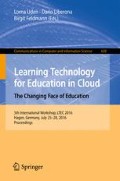Abstract
This study is framed within a conceptual approach that integrates modeling, problem solving, and the use of digital technologies perspectives in mathematical learning. It focuses on the use of a Dynamic Geometry System (GeoGebra) to construct mathematical models as a means to represent and explore mathematical relationships. In particular, we analyze and document what ways of reasoning high school students exhibit as a result of working on a mathematical task in problem solving sessions. Results show that the students rely on a set of technology affordances to dynamically visualize, represent and explore mathematical relations. In this process, the students’ discussions became relevant not only to explain their approaches; but also to contrast, and eventually refine, their initial models and ways of reasoning.
Access this chapter
Tax calculation will be finalised at checkout
Purchases are for personal use only
Notes
- 1.
The NCTM (2009) stated that “a reasoning habit is a productive way of thinking that becomes common in the process of mathematical inquiry and sense making” (p. 9).
References
Blum, W., Galbraith, P.L., Henn, H.-W., Niss, M. (eds.): Modelling and Applications in Mathematics Education. Springer, New York (2007)
Cai, J.: Commentary on problem solving heuristics, affect, and discrete mathematics: a representational discussion. In: Sriraman, B., English, L. (eds.) Theories of Mathematics Education, pp. 252–257. Springer, New York (2010)
Carlson, M.P., Bloom, I.: The cyclic nature of problem solving: an emergent multidimensional problem-solving framework. Educ. Stud. Math. 58, 45–75 (2005)
Cobb, P.: Putting philosophy to work: coping with multiple theoretical perspectives. In: Lester, F. (ed.) Second Handbook of Research on Mathematics Teaching and Learning, vol. 1, pp. 3–38. Information Age Publishing, Greenwich (2007)
Engelbrecht, J.: Adding structure to the transition process to advance mathematical activity. Int. J. Math. Educ. Sci. Technol. 41(2), 143–154 (2010)
English, L., Sriraman, B.: Problem solving for the 21st century. In: Sriraman, B., English, L. (eds.) Theories of Mathematics Education: Seeking New Frontiers, pp. 263–290. Springer, New York (2010)
Jackiw, N., Sinclair, N.: Sounds and pictures: dynamism and dualism in dynamic geometry. ZDM Math. Educ. 41, 413–426 (2009)
Kelly, A.E., Lesh, R.A.: Handbook of Research Design in Mathematics and Science Education. Lawrence Erlbaum Associates, Mahwah (2000)
Kilpatrick, J., Swafford, J., Bradford, F. (eds.): Adding it Up: Helping Children Learn Mathematics. National Academic Press, Washington, D.C. (2001)
Lesh, R., Doerr, H.M.: Symbolizing, communicating, and mathematizing: key components of models and modeling. In: Cobb, P., Yackel, E., McClain, K. (eds.) Symbolizing and Communicating in Mathematics Classrooms: Perspectives on Discourse, Tools, and Instructional Design, pp. 361–383. Lawrence Erlbaum Associates, Mahwah (2000)
Lesh, R., Sriraman, B.: Re-conceptualizing mathematics education as a design science. In: Sriraman, B., English, L. (eds.) Theories of Mathematics Education, Seeking New Frontiers, pp. 123–146. Springer, New York (2010)
Lester Jr., F.K.: On the theoretical, conceptual, and philosophical foundation for research in mathematics education. In: Sriraman, B., English, L. (eds.) Theories of Mathematics Education: Seeking New Frontiers, pp. 67–85. Springer, New York (2010)
Mason, J., Johnston-Wilder, S.: Designing and Using Mathematical Tasks, 2nd edn. Tarquin, St Albans (2006)
Moreno-Armella, L., Santos-Trigo, M.: The use of digital technologies in mathematical practices: reconciling traditional and emerging approaches. In: English, L., Kirshner, D. (eds.) Handbook of International Research in Mathematics Education, 3rd edn, pp. 595–616. Taylor and Francis, New York (2016)
National Council of Teachers of Mathematics (NCTM): Focus in high school mathematics: Reasoning and sense making. NCTM, Reston (2009)
Santos-Trigo, L.: Problem solving in mathematics education. In: Lerman, S. (ed.) Encyclopedia of Mathematics Education, 1st edn, pp. 496–501. Springer, Netherlands (2014)
Santos-Trigo, M., Reyes-Rodriguez, A.: The use of digital technology in finding multiple paths to solve and extend an equilateral triangle task. Int. J. Math. Educ. Sci. Technol. 47(1), 58–81 (2016)
Schoenfeld, A.H.: Bharath Sriraman and Lyn English: Theories of mathematics education: seeking new frontiers. ZDM Int. J. Math. Educ. 42, 503–506 (2010)
Schoenfeld, A.H.: Reflections of an accidental theorist. J. Res. Math. Educ. 41(2), 104–116 (2010)
Simon, M.A.: Amidst multiple theories of learning in mathematics education. J. Res. Math. Educ. 40(5), 477–490 (2009)
Trouche, L.: Managing the complexity of human/machine interactions in computerized learning environments: guiding students’ command process through instrumental orchestrations. Int. J. Comput. Math. Learn. 9(3), 281–307 (2004)
Zbiek, R.M., Heid, M.K., Blume, G.W.: Research on technology in mathematics education. In: Lester Jr., F.K. (ed.) Second Handbook of Research on Mathematics Teaching and Learning, pp. 1169–1207. Information Age Publishing, NCTM, Charlotte (2007)
Acknowledgement
The authors would like to acknowledge the support received from Conacyt (project reference 168543) during the development of this research.
Author information
Authors and Affiliations
Corresponding author
Editor information
Editors and Affiliations
Rights and permissions
Copyright information
© 2016 Springer International Publishing Switzerland
About this paper
Cite this paper
Santos-Trigo, M., Reyes-Martínez, I., Aguilar-Magallón, D. (2016). Digital Technologies and a Modeling Approach to Learn Mathematics and Develop Problem Solving Competencies. In: Uden, L., Liberona, D., Feldmann, B. (eds) Learning Technology for Education in Cloud – The Changing Face of Education. LTEC 2016. Communications in Computer and Information Science, vol 620. Springer, Cham. https://doi.org/10.1007/978-3-319-42147-6_17
Download citation
DOI: https://doi.org/10.1007/978-3-319-42147-6_17
Published:
Publisher Name: Springer, Cham
Print ISBN: 978-3-319-42146-9
Online ISBN: 978-3-319-42147-6
eBook Packages: Computer ScienceComputer Science (R0)

